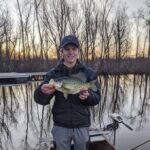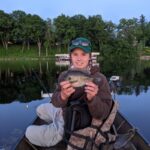Hey there, fellow anglers! If you’re looking to up your crappie game and have a blast while doing it, you’re in for a treat. Slip bobber crappie fishing is a technique that offers a boatload of excitement and is perfect for beginners and seasoned fishermen alike. In this guide, we’re diving into the nitty-gritty of slip bobber fishing for crappie, sharing tips, tricks, and personal anecdotes to help you reel in those prized catches. So grab your fishing gear and let’s get started!
Table Of Contents:
Rigging A Slip Bobber
First things first, it’s important to understand the basics of how to rig a slip bobber for crappie fishing. A slip bobber rig is comprised of a bobber stop, slip bobber, weight, swivel, and hook in that order.
The Bobber
You’ll want to match the bobber to the size of weight you are using. For example, if you are fishing with a 1/16 oz jighead, use a slip bobber that is rated for 1/16 oz. Avoid using bobbers that are too big. You want the least bit of resistance possible for a crappie to pull the rig under water. Additionally, consider using slip bobbers with brass gromets. These allow the line to slide through much easier compared to the traditional plastic ones.
If you plan on doing any crappie fishing at night, look into lighted slip bobbers to help you see when it’s dark.
The Weight
You can choose to either add weight by using split shots and inline weights or by using jig heads. When using split shots or inline weights, use a bare light wire hook. This setup works best when fishing crappie with live bait. When fishing plastics under a slip bobber, a jig head is the preferred method. Additionally, if you are fishing deep and want to keep your jig profile small, don’t be afraid to use a combination of an inline weight and jig head.

Plastics vs. Live Bait
Plastics:
Plastics have come a long way in recent years, and there are many great soft plastics available specifically for crappie. Choose a soft plastic based on the forage you are trying to imitate. To be honest, color tends to be more important than profile for crappie. Pink and chartreuse are two of my favorites, but experiment and find what works best in your lake. The benefit of plastics is that they tend to target the bigger crappie overall in my experience. Additionally, they are less easily pecked off by smaller panfish. Keep your soft plastic continually moving by twitching you slip bobber as you slowly bring it in.
Live Bait:
Live bait definitely has a time and a place when it comes to crappie fishing. You can catch crappie on nightcrawlers and leeches, but more often than not minnows are their preferred meal. Small fatheads or shiners are great options. I recommend skin hooking them just behind the dorsal fin to keep them alive and constantly moving.
Setting The Depth
Setting the depth is one of the most important steps to your slip bobber rig. The way that I do it is by using the rod as reference. Reel you slip knot to the rod tip and pull your rig alongside the rod lengthwise. If you have a 7 foot rod and your hook reaches the handle, you know you are set to 7 feet. Keep in mind to always keep your rig slightly above where the crappie are actually sitting. Crappie love to feed upwards.
Gear For Bobber Fishing
To effectively fish slip bobbers for crappie, you’ll benefit from having the right gear.
Rod
For rods, I recommend either an ultra-light or light powered spinning rod for slip bobber fishing. Having a soft rod is critical to keeping the hook pinned since crappie since they have such a soft mouth. They call them paper mouths for a reason. For length, I recommend a rod between 6’6″ and 7′. I know this may song long to some, but the added length is very helpful at achieving long casts with slip bobbers. Additionally, these longer rods tend to bend deeper into the rod blank and fight fish better as a result.
Line
As far as line goes, either fluorocarbon or monofilament will work. The key is two avoid using leaders when fishing with slip bobbers. This will impede your ability to adjust the depth and make your rig much less versatile. The benefit of monofilament is that it floats. This allows your slip bobber to sit more upright in the water. Fluorocarbon on the other hand sinks which can affect affect the way your bobber rides in the water when sitting for long periods of time. The benefit to fluorocarbon is that it has low visibility in the water, making it a good choice for clear water scenarios. Choose whichever type of line you prefer and makes the most sense for the body of water you’ll be fishing.
When To Fish A Slip Bobber For Crappie
Now that you set up with all the necessary equipment, let’s talk about the best times to use slip bobbers
Weeds
When you encounter crappie in the weeds, a slip bobber is a great tool. Set your slip bobber depth to a few feet above the tops of the weeds.
Suspended Fish
Slip bobbers are ideal to use 2hen you mark suspended schools of crappie. The benefit of using a slip bobber over a traditional bobber for this scenario is that you can adjust the depth much easier. Set your bobber depth to a few feet higher than the school of crappie are sitting. Remember that crappie always prefer eating upwards.
Cool Water
Fall through spring are great times to use a slip bobber for crappie. Cooler water temperatures make crappie less active and less prone to chasing lures as a result. For this reason, a stationary plastic or live bait offering is hard for them to turn away.
How To Fish a Slip Bobber
I like to call the two methods for fishing a slip bobber the soak and the twitch.
The Soak
This is as simple as it gets. Cast you slip bobber rig out and let it sit still. You’ll need live bait when fishing this way to impart to action for you. If allowed in your state, take advantage of using multiple lines to cover as much water as possible.
The Twitch
This technique is a more active way of fishing a slip bobber. Most people think about casting slip bobbers out and forgetting about them. The twitch retrieve refers to using your rod tip to twitch your bobber on semi-slack line. Try to twitch the bobber in place without moving it towards you much. This retrieve works best when fishing soft plastics under your slip-bobber to impart action to them.
Conservation Considerations
Before we wrap up, a word on being a responsible angler.
Selective Harvesting
If you plan on keeping a few crappie for a meal, make sure to practice selective harvest. Respect size and bag limits, and consider releasing the larger, breeding-sized crappie to ensure future generations.
Proper Handling and Release
If you are releasing crappie, handle them as short as possible to minimize stress on the fish. Additionally, avoid targeting them in water deeper than 30 ft since they will likely suffer from the effects of barotrauma.
There you have it – everything you need to know about fishing slip bobbers for crappie. Remember to choose the right size bobber for the job and weight your setup accordingly. Cast your slip bobber to key areas where you know schools of crappie are holding. Constantly experiment with retrieval methods and depths until you find something that works. Once you figure that out, it is easy to replicate with a slip bobber. So put your newfound knowledge to the test the next time you’re out on the water. Tight Lines!
More Panfish Fishing Articles:
- Lure Talk: Best Crappie Lures For Each Season

- Ice Fishing For Crappie: Everything You Need To Know

- Slip Bobber Crappie Fishing: Everything You Need To Know

- Summer Panfish Fishing: Everything You Need To Know

- Ice Fishing For Panfish: Everything You Need To Know

- Fall Panfish Fishing: Everything You Need To Know

